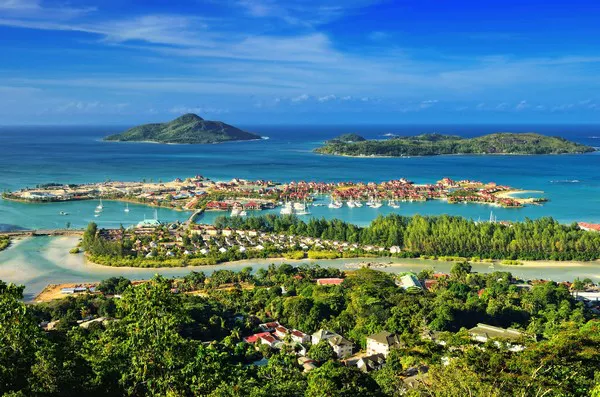Africa, renowned for its rich cultural heritage and diverse landscapes, is home to a multitude of nations varying in size, population, and development. While some African countries boast bustling metropolises and densely populated regions, others maintain a more tranquil demographic profile. In this article, we delve into the lesser-known aspect of African demographics by exploring the ten least populous countries on the continent. Through a meticulous analysis of population data, socio-economic factors, and geographical characteristics, we aim to shed light on the unique attributes and challenges faced by these nations.
Africa’s 10 Least Populous Nations
1. Seychelles
Nestled in the azure waters of the Indian Ocean, Seychelles stands out as one of Africa’s smallest nations both in size and population. With a total population hovering around 90,000 inhabitants, this archipelago nation boasts stunning natural beauty and a vibrant tourism industry. Despite its small population, Seychelles has managed to achieve significant economic prosperity, largely fueled by tourism, fisheries, and offshore financial services. However, challenges such as environmental sustainability and economic diversification remain pertinent in ensuring the long-term stability and development of the country.
2. São Tomé and Príncipe
Located off the western coast of Central Africa, São Tomé and Príncipe comprise a dual-island nation characterized by lush tropical forests and pristine beaches. With a population of approximately 220,000 people, this former Portuguese colony relies heavily on agriculture, particularly cocoa production, as a primary source of income. Despite its modest population size, São Tomé and Príncipe faces challenges related to infrastructure development, healthcare accessibility, and economic diversification. However, recent efforts to promote tourism and attract foreign investment signal a promising path towards sustainable development.
3. Comoros
Situated off the southeastern coast of Africa, the Union of the Comoros encompasses a group of volcanic islands renowned for their cultural diversity and natural beauty. With a population of around 850,000 inhabitants, Comoros faces numerous socio-economic challenges, including poverty, limited infrastructure, and political instability. However, the nation’s rich cultural heritage, coupled with its strategic location along key maritime routes, presents opportunities for economic growth and regional cooperation. By investing in education, healthcare, and infrastructure development, Comoros can harness its potential and chart a course towards a brighter future.
4. Cabo Verde
Perched off the coast of West Africa, Cabo Verde comprises a cluster of ten volcanic islands known for their vibrant music, colorful festivals, and welcoming hospitality. With a population of approximately 560,000 people, this island nation has made significant strides in economic development, particularly in tourism, renewable energy, and service industries. Despite its relatively small population, Cabo Verde faces challenges such as water scarcity, unemployment, and vulnerability to natural disasters. However, concerted efforts to promote sustainable development, enhance infrastructure, and diversify the economy bode well for the nation’s future prosperity.
5. Djibouti
Strategically located at the crossroads of Africa, Asia, and the Middle East, Djibouti serves as a vital hub for international trade and commerce. With a population of approximately one million people, this small yet strategically significant nation relies heavily on its geostrategic location, port infrastructure, and logistics services for economic growth. However, Djibouti faces challenges such as high unemployment, limited arable land, and water scarcity, exacerbated by its arid climate and rugged terrain. Despite these challenges, ongoing investments in infrastructure, renewable energy, and strategic partnerships position Djibouti as a key player in regional development and integration.
6. Guinea-Bissau
Tucked away on the West African coast, Guinea-Bissau is a small nation with a rich cultural heritage and a turbulent political history. With a population of approximately 1.9 million people, this former Portuguese colony grapples with poverty, political instability, and illicit drug trafficking. Despite these challenges, Guinea-Bissau possesses abundant natural resources, including fertile agricultural land and fisheries, offering opportunities for economic development and poverty alleviation. By prioritizing good governance, rule of law, and sustainable development initiatives, Guinea-Bissau can unlock its potential and pave the way for a brighter future.
7. Eswatini
Formerly known as Swaziland, Eswatini is a landlocked kingdom nestled between South Africa and Mozambique, renowned for its rich cultural traditions and stunning landscapes. With a population of approximately 1.2 million people, Eswatini faces challenges such as high HIV/AIDS prevalence, youth unemployment, and income inequality. However, the nation’s commitment to preserving its cultural heritage, coupled with investments in education, healthcare, and infrastructure, underscores its resilience and determination to overcome socio-economic challenges. By leveraging its cultural heritage, promoting sustainable tourism, and fostering economic diversification, Eswatini can chart a path towards inclusive growth and prosperity.
8. Lesotho
Perched high in the rugged mountains of Southern Africa, Lesotho is a small, landlocked kingdom renowned for its breathtaking scenery and rich cultural heritage. With a population of approximately 2.1 million people, Lesotho faces numerous socio-economic challenges, including high unemployment, poverty, and limited access to healthcare and education. However, the nation’s abundant water resources, coupled with its potential for hydroelectric power generation and tourism development, offer opportunities for economic growth and poverty alleviation. By investing in infrastructure, skills development, and sustainable resource management, Lesotho can harness its potential and improve the livelihoods of its people.
9. Gambia
Snaking along the banks of the Gambia River, The Gambia is a small West African nation renowned for its warm hospitality, vibrant culture, and stunning natural beauty. With a population of approximately 2.5 million people, The Gambia faces challenges such as poverty, unemployment, and environmental degradation. However, recent political developments and efforts to promote tourism, agriculture, and renewable energy signal a renewed sense of optimism and potential for economic growth. By investing in education, infrastructure, and sustainable development initiatives, The Gambia can capitalize on its natural assets and improve the well-being of its citizens.
10. Mauritius
Nestled in the warm waters of the Indian Ocean, Mauritius is a small island nation renowned for its stunning beaches, vibrant culture, and economic prosperity. With a population of approximately 1.3 million people, Mauritius boasts a diverse economy driven by tourism, manufacturing, financial services, and information technology. Despite its small size, the nation has achieved remarkable social and economic progress, characterized by high levels of human development, political stability, and environmental sustainability. However, challenges such as income inequality, youth unemployment, and environmental degradation require continued efforts to ensure inclusive and sustainable development for all Mauritians.
See Also: 10 Countries With The Highest Death Rates
Conclusion:
In conclusion, the ten least populous countries in Africa represent a diverse tapestry of cultures, landscapes, and socio-economic challenges. From the tranquil shores of Seychelles to the rugged mountains of Lesotho, each nation faces unique opportunities and obstacles on its path to development. By leveraging their natural assets, promoting sustainable development, and fostering regional cooperation, these nations can unlock their potential and pave the way for a brighter future for all their citizens. As Africa continues to evolve and progress, it is essential to recognize the contributions and aspirations of all its nations, big and small, in shaping the continent’s collective destiny.
You Might Be Interested In:
























